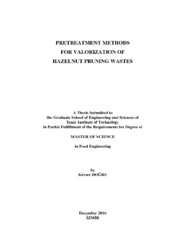Please use this identifier to cite or link to this item:
https://hdl.handle.net/11147/5697Full metadata record
| DC Field | Value | Language |
|---|---|---|
| dc.contributor.advisor | Büyükkileci, Ali Oğuz | en_US |
| dc.contributor.author | Doğru, Kevser | - |
| dc.date.accessioned | 2017-06-06T06:36:21Z | - |
| dc.date.available | 2017-06-06T06:36:21Z | - |
| dc.date.issued | 2016-12 | - |
| dc.identifier.citation | Doğru, K. (2016). Pretreatment methods for valorization of hazelnut pruning wastes. Unpublished master's thesis, İzmir Institute of Technology, İzmir, Turkey | en_US |
| dc.identifier.uri | http://hdl.handle.net/11147/5697 | - |
| dc.description | Thesis (Master)--Izmir Institute of Technology, Food Engineering, Izmir, 2016 | en_US |
| dc.description | Full text release delayed at author's request until 2020.01.26 | en_US |
| dc.description | Includes bibliographical references (leaves: 72-81) | en_US |
| dc.description | Text in English; Abstract: Turkish and English | en_US |
| dc.description.abstract | Turkey is the world leader in hazelnut production and a large amount of residues is produced during its harvesting and processing. So far, the residues of hazelnut production had no economic value and usually burned in the fields. Obtaining valuable products such as ethanol from hazelnut pruning waste (HPW) can add value to those. Ethanol produced by microorganisms via fermentation is a promising alternative biofuel. Ethanol has been produced for a long time from sugary substances, while lignocellulosic biomasses (LCBs) are interesting alternative to fossil fuel based resources in order to have a sustainable production process. Liquid hot water (LHW) treatment is one of the pretreatment processes necessary to facilitate enzymatic hydrolysis of cellulose into glucose before ethanol fermentation. Organosolv is similar to LHW treatment except that ethanol-water mixture is generally used is the liquid part instead of only water. LHW could remove the hemicelluloses from the lignocellulosic matrix to some extent, while adding H2SO4 improved the hemicellulose removal. Organosolv was effective on removal of lignin as well as of hemicellulose. Acid catalysis improved the hemicellulose solubilization in organosolv, like in LHW treatment. After acid catalyzed organosolv, cellulose content of the HPW was increased to 67.91%. This sample was hydrolyzed with a conversion efficiency of 87.32%. Hydrolysate containing 60.63 g/L glucose was used as the medium for ethanol production using Saccharomyces cerevisiae. At an 83.49% theoretical yield, 22.2 g/L ethanol was obtained after 6 h. These results demonstrated that hazelnut pruning waste has potential to be used as a feedstock for ethanol production. | en_US |
| dc.description.abstract | Türkiye, fındık üretiminde dünya lideri olup bu ürünün hasadı ve işlenmesi sırasında büyük miktarda atık açığa çıkmaktadır. Fındık budama atıklarının büyük bölümü tarlalarda sadece yakılarak değerlendirilmektedir. Bu atıkların değerlendirilmesi ve etanol gibi katma değeri yüksek ürünlere dönüştürülmesi ekonomiye fayda sağlayabilir. Mikroorganizmalar tarafından fermantasyon yolu ile üretilen etanol ümit verici bir alternatif biyoyakıttır. Üretiminde genellikle kolay fermente edilebilen karbonhidratlar kullanılırken, atık bitkisel biyokütlenin kullanılmasına yönelik bir eğilim vardır. Lignoselülozik biyokütledeki selüloz, hemiselüloz ve lignin ile karmaşık ve kuvvetli bir yapı oluşturduğundan, selüloz erişilebilirliğinin arttırılması için önişlem gereklidir. Sıvı sıcak su (SSS) işlemi, etanol fermantasyonundan önce selülozun glikoza enzimatik hidrolizini kolaylaştırmak için gerekli olan önişlem proseslerinden biridir. Organosolv, SSS önişlemine benzer olmakla birlikte ortama sadece su yerine etanol-su karışımı eklenerek yapılan bir önişlemdir. SSS hemiselülozları lignoselülozik yapıdan bir miktar uzaklaştırabilirken, H2SO4 ilavesi hemiselülozun uzaklaşmasında daha ekili olmuştur. Organosolv, hemiselülozun yanı sıra ligninin de uzaklaştırılmasında etkili olmuştur. Asit katalizörü, SSS uygulamasında olduğu gibi organosolv uygulamasında da hemiselülozun çözünürlüğünü geliştirmiştir. Asit katalizörü eklenerek uygulanan organosolv ile, fındık budama atıklarının selüloz içeriği %67.91'e yükselmiştir. Bu örnek %87.32'lik glikoz dönüşüm verimliliği ile hidroliz edilmiştir. Saccharomyces cerevisiae kullanılarak etanol üretimi için ortam olarak 60.63 g/L glikoz içeren sıvı kullanılmıştır. Fermantasyon işleminde 6 saat sonra 22.2 g/L etanol elde edilerek teorik verim 83.49% olarak hesaplanmıştır. Bu sonuçlar, fındık budama atığının etanol üretimi için bir hammadde olarak kullanılma potansiyeline sahip olduğunu ortaya koymuştur. | en_US |
| dc.format.extent | xii, 85 leaves | en_US |
| dc.language.iso | en | en_US |
| dc.publisher | Izmir Institute of Technology | en_US |
| dc.rights | info:eu-repo/semantics/openAccess | en_US |
| dc.subject | Bioethanol | en_US |
| dc.subject | Agricultural wastes | en_US |
| dc.subject | Pretreatment | en_US |
| dc.subject | Valorization | en_US |
| dc.subject | Hazelnut | en_US |
| dc.title | Pretreatment methods for valorization of hazelnut pruning wastes | en_US |
| dc.title.alternative | Fındık budama atıklarının değerlendirilmesi için ön işlem yöntemleri | en_US |
| dc.type | Master Thesis | en_US |
| dc.institutionauthor | Doğru, Kevser | - |
| dc.department | Thesis (Master)--İzmir Institute of Technology, Food Engineering | en_US |
| dc.request.email | kevserdogru@hotmail.com | - |
| dc.request.fullname | Kevser Doğru | - |
| dc.relation.publicationcategory | Tez | en_US |
| item.languageiso639-1 | en | - |
| item.fulltext | With Fulltext | - |
| item.openairecristype | http://purl.org/coar/resource_type/c_18cf | - |
| item.openairetype | Master Thesis | - |
| item.grantfulltext | open | - |
| item.cerifentitytype | Publications | - |
| Appears in Collections: | Master Degree / Yüksek Lisans Tezleri | |
Files in This Item:
| File | Description | Size | Format | |
|---|---|---|---|---|
| T001560.pdf | MasterThesis | 2 MB | Adobe PDF |  View/Open |
CORE Recommender
Page view(s)
122
checked on Jul 22, 2024
Download(s)
110
checked on Jul 22, 2024
Google ScholarTM
Check
Items in GCRIS Repository are protected by copyright, with all rights reserved, unless otherwise indicated.